African Cichlids are one of the most popular groups of fish among aquarists. These fish have remarkable beauty and a unique charm, but there’s more to them. What actually sets these fishes apart is their long lifespan. Unlike most freshwater fish, the African Cichlid lifespan extends to a whopping 10 to 12 years, and even more in optimal conditions. If that’s not enough, follow along as we discuss more amazing facts about the African Cichlid.
We understand how an aquarist has a heart-to-heart connection with his fish. However, most fish die after a short period, due to their small lifespan. But that’s not the case with the African Cichlid, this fish will stay with you for a long time!
Let me ask: Do you think there is a fish with a longer lifespan than the African Cichlid? Read the article below to find out and tell me in the comments below!
Although African Cichlids have a longer lifespan, they require specific conditions to thrive. Additionally, this lifespan is affected by many factors. In today’s article, we discuss such factors that can affect a Cichlid’s life span. We will also discuss some tips to extend your Cichlid’s lifetime, so read the following article and add some extra years to your fish’s vibrant life.
Understanding African Cichlids
The African Cichlids belong to the freshwater lakes of Africa. Particularly found in Lake Malawi, Lake Tanganyika, Lake Victoria, and their tributaries. These environments provide diverse habitats with sufficient shelter and food.
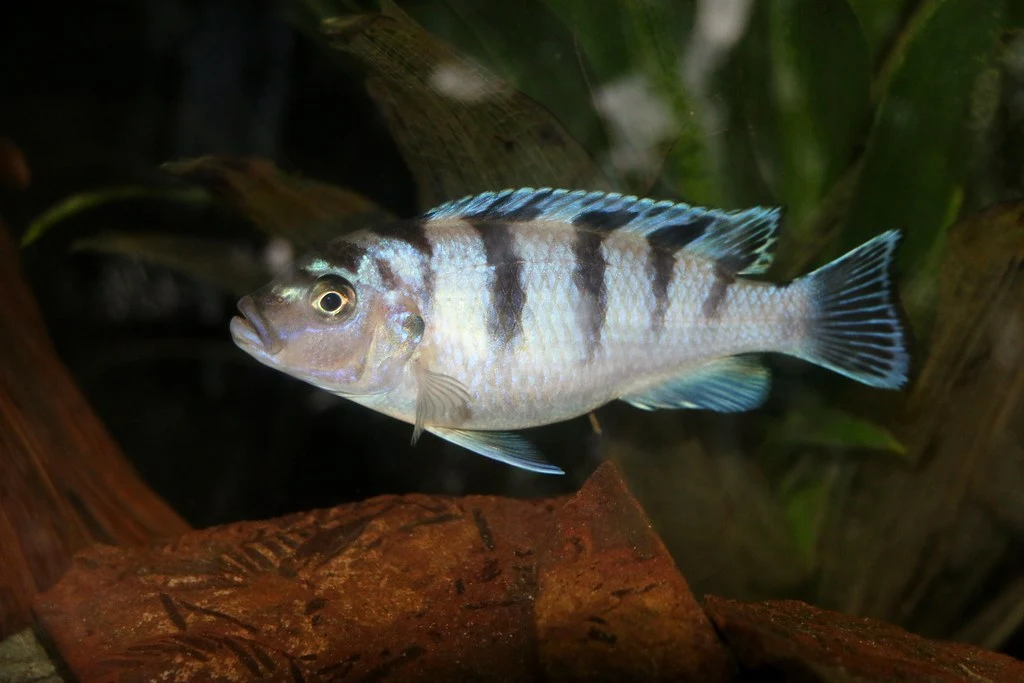
Interestingly, these Cichlids have a diverse variety of almost 1300 species. They also have multiple habitats thanks to their adaptable nature. Each of these fish has a unique behavior and appearance.
Generally, the African Cichlids have stunning blue and yellow body. Their bright bodies exhibit intriguing patterns that add to their beauty. Moreover, these patterns play a crucial role as they are a sign of dominance. The Cichlids with more colorful patterns are also more desirable for mating. These striking looks also make the African Cichlids popular in the fish trade market.
The African Cichlid has a long lifespan that’s like no other freshwater fish. They can live up to 15 years if proper care is provided. Because of their robust nature, these fish can prove to be long-term companions. Moroever, just a well-maintained tank that mimics its natural habitat and some extra care is more than enough for this fish to thrive.
African Cichlid Lifespan in the Wild
African Cichlids thrive in diverse freshwater habitats of East Africa. These habitats offer a range of rocky shores and sandy bottoms, ideal for the African Cichlid. Moreover, these natural habitats provide a lot of natural food source shelter to the fish.

However, the African Cichlid has to face many challenges in the wild. Predation and loss of habitat are one of the biggest reasons for its short lifespan in the wild. Additionally, competition for food and shelter also makes it hard for the fish to survive. So, it’s safe to say that they live a smaller life in the wild, as compared to life in captivity.
As nature’s thumb rule, the fittest must survive. In the case of African Cichlids, large and healthy species have more chances of survival. Large sizes allow the fish to dominate their territory and scare off predators.
African Cichlid Lifespan in Captivity
In captivity, African cichlids exhibit a lifespan of 10 to 15 years. However, it depends on the care and tank conditions that are provided. In some cases, this fish has even thrived for longer than 15 years. This extended lifespan requires controlled water conditions and balanced nutrition. A tank that mimics its natural habitat also helps to make your underwater friend feel right at home.

By addressing specific requirements, you can do it too! Come along as we discuss the natural requirements and care for a healthy and long African Cichlid Lifespan.
Factors Affecting African Cichlid Lifespan
The African Cichlids are beautiful freshwater fishes with an interestingly long lifespan. However, this long life is only achievable if specific requirements are fulfilled. Here are some of the major factors involved in expanding the African Cichlid Lifespan.
Diet
African Cichlids have a diverse diet including algae, insects, and small crustaceans. However, the dietary options can vary from fish to fish. Because of their diversity, some of them might be algae eaters while others might eat meat as well. Make sure you know what your African Cichlid prefers to eat.
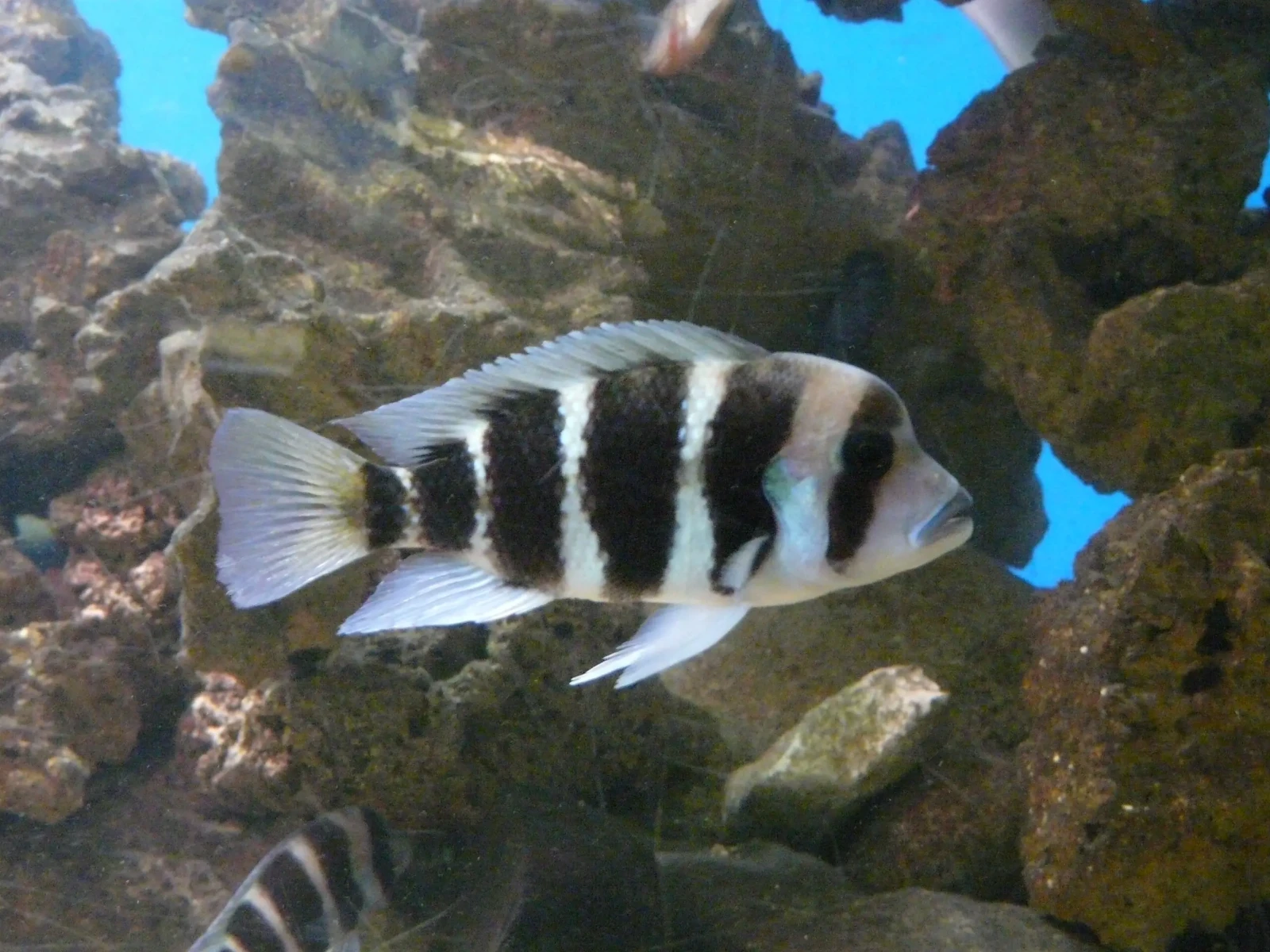
Generally, most of the African Cichlids have a varied diet. This mixed diet is crucial for their longevity as it provides the required nutrition. So it’s important to provide your fish with an inclusive diet with many options. Foods like brine shrimp and worms and occasional vegetable matter should be provided. These foods have enough protein and nutrients for the fish to grow and thrive in captivity.
Additionally, you must make a routine for feeding your fish. If fed without and proper schedule, the fish might end up having health issues and diseases. Overfeeding must be avoided as well. Here is a general routine, but we encourage you to adjust it according to your fish’s eating habits.
| Time | Meal |
| Morning: | High-quality pellets are ideal for the morning meal. These provide essential nutrition for the fish to stay active for the day. |
| Midday: | Offer a small portion of blanched vegetables for the daytime. spinach and zucchini are ideal. These foods will add fiber to the diet and make digestion easier. |
| Evening: | Provide live or frozen foods such as brine shrimp, bloodworms, or daphnia. These foods will add the necessary proteins and fats for healthy growth. |
Lastly, you can switch the diet twice a week, like adding spirulina or algae-based supplements to the diet. This will add some contrast to the fish’s daily feeding routine.
Follow these guidelines for a longer African Cichlid lifespan. Remember, you are what you eat! and the same goes for the fish. If they eat healthy, they become healthy and live a long life.
Tank Parameters
African Cichlids require stable water conditions to thrive. Their natural habitat has stable water temperatures and moderate flow. Thus for a longer African Cichlid lifespan, you must provide a tank with the same parameters. Here’s a breakdown.
The fish tank water temperature must be between 76 to 82 degrees Fahrenheit. The tank water pH must be between 7.5 to 8.5. Additionally, the ammonia and nitrate levels in the tanks must be safe.
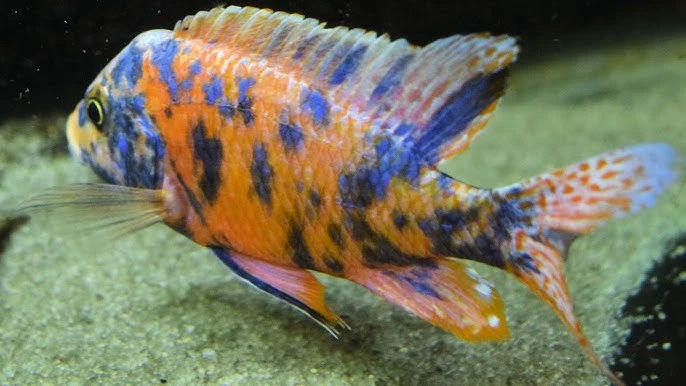
Lastly, to maintain the fish tank water quality, make sure to regularly change the tank water. It’s ideal to change around 10 to 20 percent of the tank water, every week. This way excess nutrients and toxins are removed. A fresh and lean environment is a must for a long African Cichlid Lifespan.
Moreover, you could use a high-quality filter like (Filter here). This way you can manage the tank bio load effectively. Make sure to clean the tank filter every 4 to weeks, but not too often. Using a gravel filter to clean the tank substrate regularly can be beneficial too.
Tank Size
Tank size is crucial for a longer African Cichlid Lifespan. In general, an African Cichlid requires a minimum of 55 gallon tank to thrive. However, a larger 75 gallon tank is better as it reduces stress and chances of aggression. Large tanks also offer moving swimming space, just like their natural habitat.
As this fish has a territorial nature, it’s best to provide ample space and not overcrowd the tank. Any sort of stress can lead to health issues and aggression in the tank. You can keep about 6 to 8 similar temperament Cichlids in one tank, but make sure they have enough space to thrive. To minimize territorial disputes, increase 10 to 15 gallons of space for each extra Cichlid.
Tank Mates
African Cichlids have a robust and adaptable nature. However, they have specific tankmate requirements. In their natural habitat, they coexist with many fish but with territorial behavior.
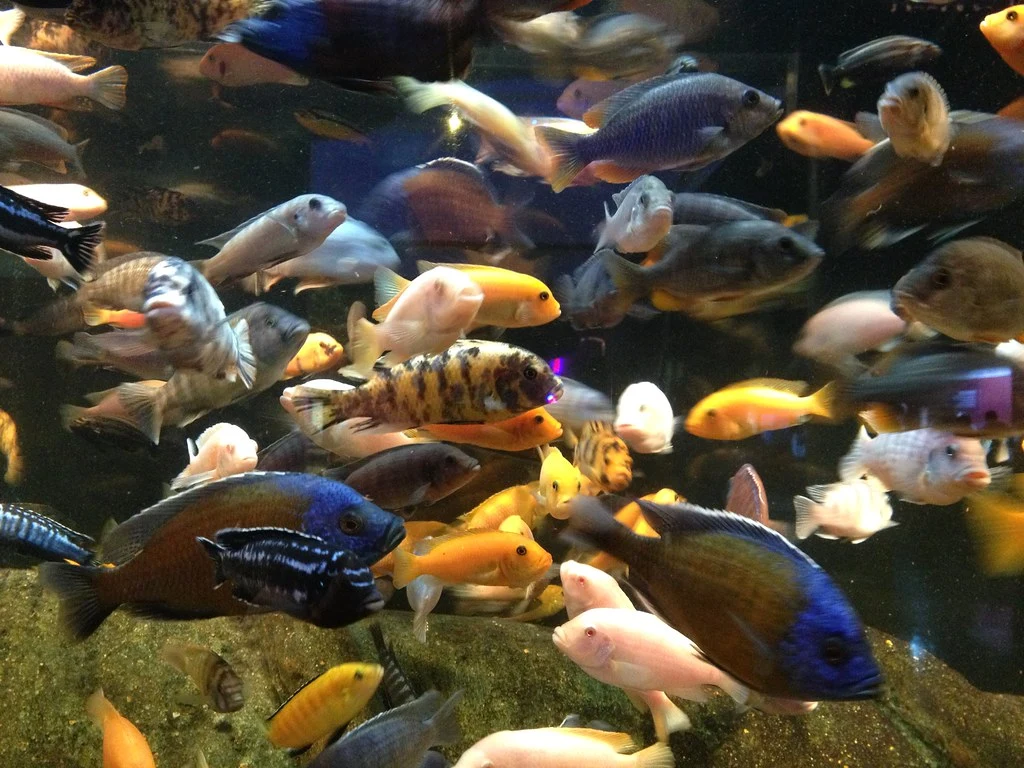
In captivity, they should be paired with fish that can handle some aggression. For example, catfish and larger catfish are ideal as they aren’t very sensitive. Although African Cichlids can manage some level of bullying, larger and more aggressive tankmates that can harm the Cichlids must be avoided. Any sort of stress and injury to the African Cichlid can reduce their lifespan. It’s best to choose robust and non-aggressive tankmates, here are some suggestions
- Synodontis Catfish
- Rainbowfish
- Plecos
- Geophagus
- Large Barbs
- Corydoras Catfish
- Silver Dollars
It’s best to double check tankmate compatibility for your specific Cichlid. Some Cichlids are solitary while others aren’t. However, the above-given tankmates are compatible with most Cichlids. All in all, tankmates are very important when extending your African Cichlids Lifespan. Their companions affect their health and longevity directly. So, it’s best to consider compatibility when choosing tankmates, the compatibility will vary from fish to fish.
Pssst! Do you know which fish can live longer than the African Cichlid? I mean, sure the African Cichlid Lifespan is interestingly amazing, but the Koi Carp can thrive for an astonishing 20 years.
Top 5 Cichlids with Long Life
Interested to find out about more Cichlids with Long Lifetimes? Let’s discuss some of the most popular Cichlids with Long Lifespans. These Cichlids are guaranteed to be the centerpiece of your aquarium for a long time. Here are their general details along with their lifespans, just in case you want to add one to your tank!
Emperor Cichlids
Emperor Cichlids are known for their beautiful bodies and stunning colors. These fish have a long lifespan of about 10 to 15 years in captivity.

The Emperor Cichlid has a unique body shape and can reach up to 20 inches in length. Being one of the largest Cichlid species, this fish is a feast to the eyes. With captivating colors like blue, yellow, and sometimes green, they also have unique patterns. Moreover, a metallic sheen and grey hue adorn their body, making them shimmer under light.
In terms of natural habitat, they share the same rivers and rocky shores of Lake Tanganyika with the African Cichlids. The ideal water temperature and pH are the same for the African and the Emperor Cichlids.
Frontosa Cichlids
Frontosa Cichlids are also well known for their striking beauty and vibrant colors. This fish can live as long as 15 to 25 years, making it one of the longest living fish. However, proper care is required for it to reach such astonishing years.
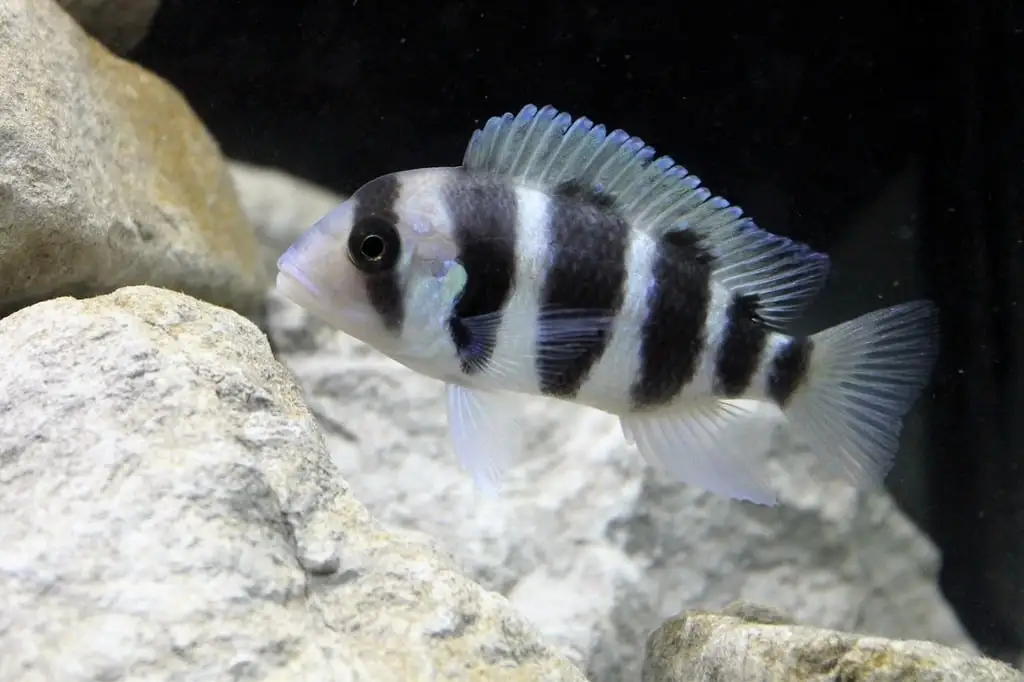
In terms of appearance, the Frontosa Cichlid has a long body of 15 inches. Along with that, it has a distinctive hump on its forehead, that looks like a crown. Moreover, this fish is adorned with blue and black stripes, which make it stand out in any aquarium.
The water parameters for this fish are slightly different from the African Cichlid. It requires a water temperature of 76 to 80 degrees Fahrenheit. A pH range of about 7.8 to 9.0 is necessary as well. Moreover, the water changes and cleanliness requirements are standard.
Mbuna Cichlids
Mbuna cichlids are native to the rocky shores of Lake Malawi. This fish has a reputation for its engaging behavior and vibrant colors. It can live up to 10 years in its natural habitat. However, in captivity, it can thrive for up to 12 years, if required care is provided.
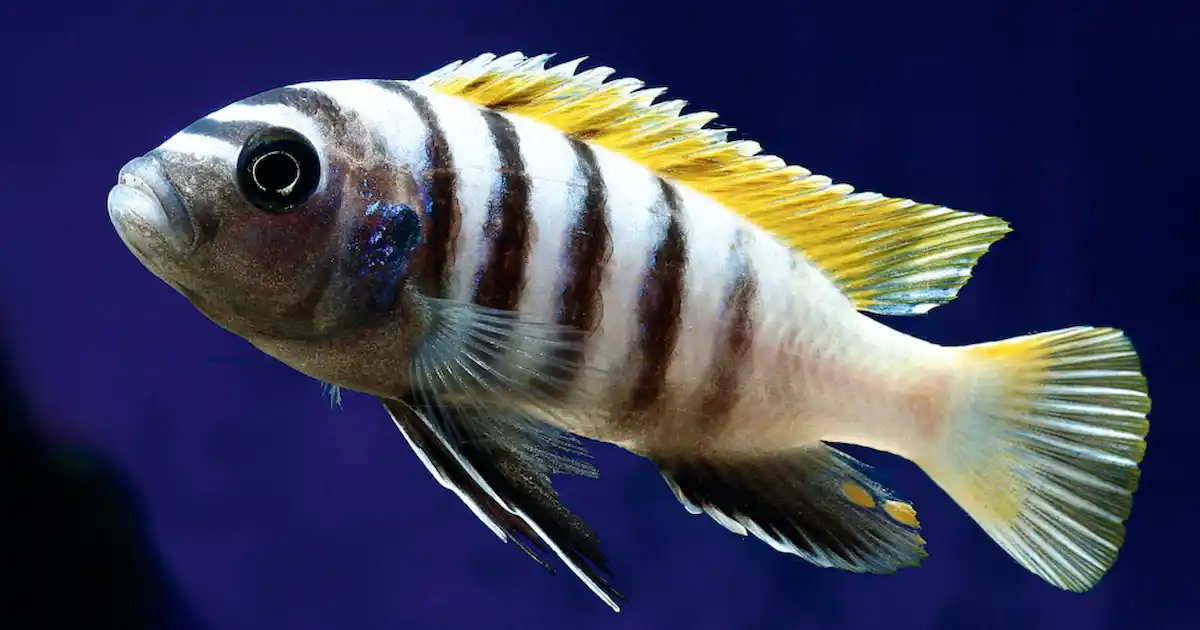
In terms of appearance and size, this fish can grow up to 4 to 6 inches in length. Along with that, it has striking colors ranging from bright yellows to deep blues. This fish has a moderate size so a 55 gallon tank is enough for 5 to 10 fish.
To maintain a healthy lifestyle for this fish, the tank should have a water temperature of 76 to 82 degrees Fahrenheit. The pH should be 7.8 to 8.6. Moreover, the water should be hard, with high mineral contents.
For a more natural habitat for the fish, add a lot of caves and hiding spots in the tank. This setting mimics its natural habitat and allows natural behavior. you must maintain standard hygiene in the tank as well. Regularly change 10 to 20 percent water, every week.
Peacock Cichlids
Peacock cichlids are native to the famous Lake Malawi. Generally, they thrive in clear and rocky shores. Along with their engaging nature, they have stunning and colorful appearances. Just like their Mbuna cousins, this fish can live up to 10 years in its natural habitat, and up to 12 years in captivity. However, providing them with proper care is crucial for ensuring a longer lifespan.
Moving on to looks, the Peacock cichlids can grow up to 6 to 8 inches in length. As the name suggests, this beautiful fish has varied colors, just like a fish. Generally, their body is adorned with colors like red, orange, deep blue, and green.
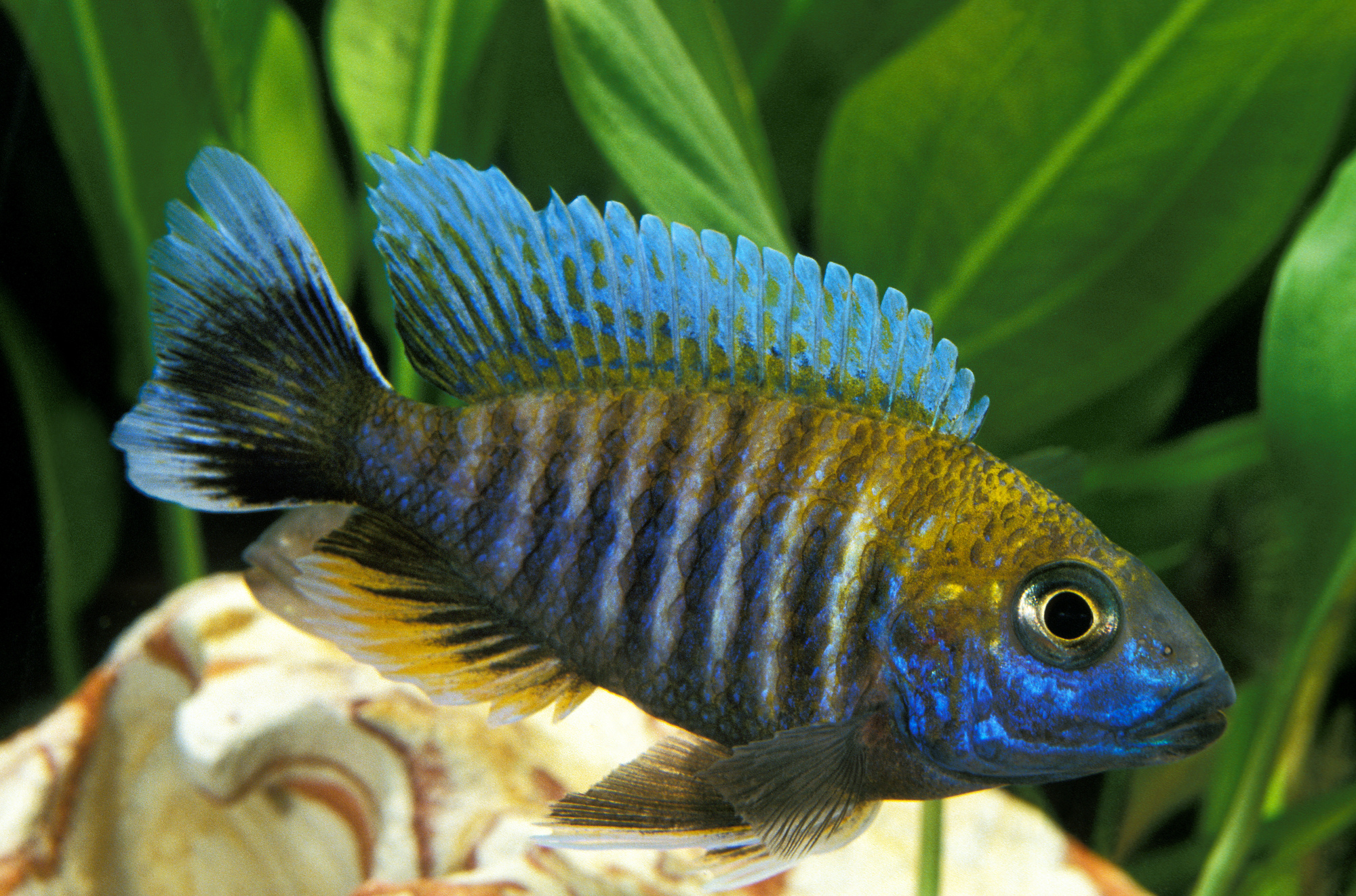
In terms of tank setup, this moderate-sized fish requires at least a 75 gallon tank, usually for a group of 6 to 8 fish. The tank pH must be between 7.8 to 8.6 while the temperature should be between 76 to 82 degrees Fahrenheit. It is best to keep the water hard with high mineral contents to mimic the fish’s natural habitat.
Talking about appearance and size, Peacock cichlids can grow up to 6 to 8 inches in length. They are renowned for their vivid and varied coloration, which ranges from bright reds and oranges to deep blues and greens. Due to their moderate size and active nature, a 75-gallon tank is recommended for a group of 6 to 8 fish.
To ensure a healthy habitat, maintain the above-given parameters. Also, add natural plants and hiding spots like caves. These areas would be used as breeding grounds, encouraging the fish to feel at home.
Tropheus
Tropheus cichlids are native to the stunning Lake Tanganyika. Like its Cichlid cousins, this fish likes to live on clear, rocky shores. Similarly, its lifetime is the same as other Cichlids, 10 years in the wild and 12 years in captivity.
Talking about its appearance, this fish can reach up to 4 to 6 inches. Celebrated for vivid hues, this fish has bright red, yellows, and deep blue colors. Moreover, their bodies are adorned with beautiful body patterns that complete the look.
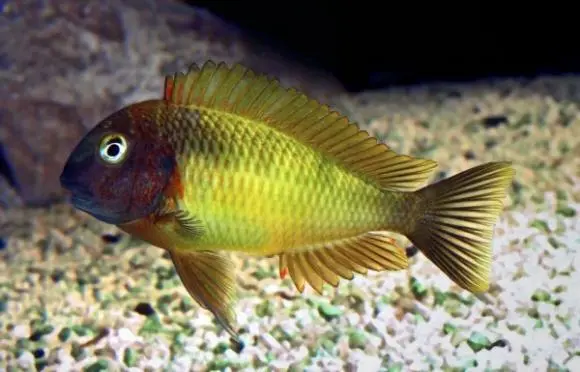
There are 2 prominent variations in this fish, Here’s a quick intro to both:
Tropheus duboisi: This variation of Tropheus has a beautiful blue and white coloration.
Tropheus moori: This variation of Tropheus has a bright yellow body, with darker markings that contrast with the base color.
In terms of tank, this fish requires a spacious size of 75 gallons, thanks to its territorial and active nature. The tank must maintain and pH between 7.8 to 8.6 and a temperature between 76 to 82 degrees. The water should be hard, with high mineral content to replicate their natural habitat. The cleanliness routine and tank setup are the same as for both the Tropheus and the Peacock Cichlids
FAQ’s
How Long Do African Cichlid Live in the Wild?
In the Wild African Cichlid’s average lifespan is about 10 years. However, due to predation and loss of habitat, this fish has a smaller lifespan in the wild.
How Long Do African Cichlid Live in Captivity?
In captivity, African Cichlids tend to live a longer life of about 10 to 12 years. If proper care and an optimal lifestyle is provided, this African Cichlid lifespan in captivity can even extend to 15 years or more.
What is another name for the Malawi Cichlid?
The Cichlids from the Great Malawi Lake are also known as the Malawi fish or the Malawi Cichlids.
Can A Cichlid Live by Itself?
Yes, African Cichlids usually prefer to live alone or in their own flock. They do not require other fish companions or plants.
What is the Oldest African Cichlid?
Mahengechromis is a group of Cichlids that includes one of the oldest Cichlids to ever exist. These Cichlids existed at a time when the species was quite different from today’s African Cichlid.
Conclusion
All in all, today we discussed the African Cichlid lifespan and its basic introduction. For more detail, we discussed the African Cichlid lifespan in captivity and the Wild. Additionally, we explored the factors that affect the African Cichlid lifespan like diet, tank size, tank setup, and tank mates.
In Essence, the African Cichlid is a diverse group of fish that are native to the great lakes of Africa. These fish have a long lifespan of about 10 to 12 years when provided with required care. Maintaining a proper care routine that encompasses factors like diet, tank setup, and tank mates is an effective way to extend the African Cichlid lifespan. Lastly, we explored some of the most vibrant and popular African Cichlid Species.
Let us know which was your favorite type of African Cichlids. Was it the Tropheus or the Frontosa? Share your choice and any queries in the comments below!

